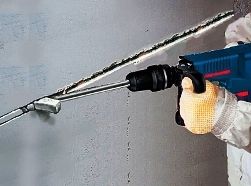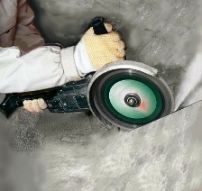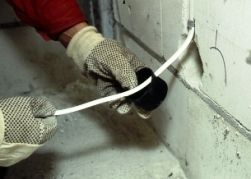Categories: Electrician at home, Electric installation work
Number of views: 211788
Comments on the article: 25
How to make a shtroba and fasten a cable in it
 In the vast majority of cases when installing hidden electrical wiring You can’t do without such a dirty and noisy procedure as strobing.
In the vast majority of cases when installing hidden electrical wiring You can’t do without such a dirty and noisy procedure as strobing.
Wires and cables must be hidden, but how to do it without a gate, if we just have a plain wall of concrete or brick? Moreover, the harness of these wires is sometimes more than impressive, especially in places connected to the apartment switchboard.
1. Markup
Strobing and laying of cable harnesses must be taken care of long before the final decoration of the room: it is when the apartment does not yet have a trace of furniture, no items, no wallpaper, no linoleum, nothing at all. In a word - bare walls, as in one famous TV show.
On these bare walls, we determine and mark the route along which cable lines will run through us. Marking can be done with a construction pencil and level. It will not be amiss to recall here that the cable lines should not be located anyhow, but should go either horizontally under the ceiling (at a height of 2.5 m), or strictly vertically along a plumb line. No diagonal transitions and horizontal segments at a low level are categorically allowed.
When marking the walls, we immediately determine the location of sockets, switches and junction boxes, because the holes in the wall for their installation will need to be performed at the same stage as the strobes for laying the cable. The width of each strobe is determined in accordance with the number and cross-section of the cable that will be fixed in it.
See here for more details: How is the marking performed during wiring
2. Strobing
Having completed the markup, we move on to the next question of primary importance. How to dash? There is plenty to choose from.
Most often used to perform strobes hammer drill with one of the special nozzles. The first of these nozzles is called - strobe. The strobe is a slightly curved blade with a longitudinal groove. The end of this scapula is pointed and intended to be deepened into the pierced strobes. Work with the strobe should be in pure shock mode, without rotation. The strobe is neat and deep from it. However, using this device to perform the strobe wider than the strobe itself can be done in just a few tricks, which, of course, is not very convenient.
Another nozzle often used for hammering with a rotary hammer is a regular flat shoulder blade. The principle of working with it is about the same as with the strobe, but the performance is slightly lower.
Strange as it may seem, ordinary sharp peaks for a punch or even a borax are also sometimes used for strobing - when there is nothing else at hand, and the volume of work is very small.
 Nevertheless, one can’t expect great performance when chipping with a rotary hammer, especially when it comes to chipping concrete walls. Therefore, with large volumes of work, many electricians use a disk cutting tool to perform the strob.
Nevertheless, one can’t expect great performance when chipping with a rotary hammer, especially when it comes to chipping concrete walls. Therefore, with large volumes of work, many electricians use a disk cutting tool to perform the strob.
As such, it is often suitable angle grinder (angle grinder), or, more simply, diamond segmented disc grinder. With its help, cuts are made along the edges of the strobe to the required depth, and the middle part is subsequently easily knocked out using the same punch. Despite the seemingly much larger number of work operations, chasing with a grinder is much more productive than the same work when using only a perforator. The reason is that the grinder makes each cut very quickly in one single pass.
The most productive tool for strobing is chipper - a device very similar to a grinder.The chipper has two cutting discs located parallel to each other. The distance between these discs is adjustable, which means that you can set the width of the strobe within the required limits. The position of the disks relative to the supporting surface, that is, the depth of the strobing, also changes.
Disc cutting tools have only one drawback compared to a rotary hammer. Of course, there are a lot of dust and dirt when ditching with a puncher, but from the cutting disc this dust does not even fly in clubs, but in a continuous stream. If an electrician neglects personal protective equipment when gouging with a grinder or stroborez, then having completed several objects, he risks having a lung and / or eye disease.
Therefore, goggles, a respirator and earplugs when performing a strob are far from a luxury, even if you work with a perforator. Your health is always more expensive. Professional chippers, by the way, are equipped not only with a protective casing for disks, but also with a standard pipe for connecting an industrial vacuum cleaner, which can absorb most of the dust produced.
3. Cable installation
And the shtroba is completed, the dust and fog have dissipated, and you can proceed with the installation of the cables. Unfortunately, the requirement for the removability of hidden electrical wiring when laying the cable in the strobe is most often neglected. The execution of large and wide strobe, which could accommodate cable conduitPerhaps not always.
Therefore, as a rule, cables are laid in harnesses in a strob without any additional protection. Insulation of the most popular for home installation cable - VVGng - quite reliable and does not fail with this method of installation.
You can fix the cable in the strobe in one of the following ways:
3.1 Using a perforated strip. It was precisely these nylon perforated strips that were used in the mass in the construction of our “favorite” panel “Khrushchevs”. The strip was fastened across the strobes using dowels and reliably held the entire mass of cables, regardless of their number.
 3.2 By mounting aluminum strip. Such is sold in any store electricians. Actually, it’s not necessary to buy it either: if you have free time and patience, you can make it by cutting any thin and ductile metal.
3.2 By mounting aluminum strip. Such is sold in any store electricians. Actually, it’s not necessary to buy it either: if you have free time and patience, you can make it by cutting any thin and ductile metal.
For mounting, the strip makes its way in the middle and is screwed to the bottom of the gate using the popular pair of “self-tapping screw”. Cables are laid on a strip from above, and its ends are bent with pliers, forming a tight and reliable lock. The method, of course, is time-consuming, but still very popular.
3.3 It is possible to fasten the cable with alabaster. We pull the cable line along the strobe and immediately fix it with the solution, which we keep at hand. The disadvantage of this method is that the alabaster solution cannot be diluted in large quantities due to the fact that it dries very quickly.
3.4 The most “advanced” and productive way of attaching the cable to the gate is to fasten with dowel clamps. Dowel clamp - This is a dowel with an installation size of 6 mm. At the end of it there is a special loop that allows you to hold the cable harness. Thus, installation using dowel clamps is very simple: you just need to punch a series of holes with a puncher, and then insert the dowel clamps with a fixed plait into them.
We recommend reading:How to lay the cable from the shield to the outlet when connecting the electric stove
See also at e.imadeself.com
:
